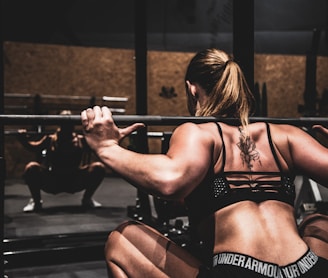Squat Function
Whether you're an athlete seeking to enhance your performance or someone striving to build a powerful lower body, the squat is your gateway to greater strength, balance, and resilience.
Eddie Francisco


The Squat's Sturdy Foundation
In the realm of strength training, the squat stands as the cornerstone of lower body development and overall functional fitness. From the classic squat to variations like the sumo squat and front squat, this comprehensive guide delves deep into the world of squatting. We will explore the unique benefits of each variation, the muscles they target, and the impact they can have on your physical appearance, athletic prowess, daily health, and everyday activities. Whether you're an athlete seeking to enhance your performance or someone striving to build a powerful lower body, the squat is your gateway to greater strength, balance, and resilience.
Understanding the Squat: A Brief Overview
The squat is a compound exercise that involves bending your knees and hips to lower your body while maintaining an upright torso. This fundamental movement primarily targets the quadriceps, hamstrings, glutes, and lower back muscles.
1. Basic Squat
Benefits:
Develops overall lower body strength, particularly in the quadriceps, hamstrings, and glutes.
Enhances core stability and balance.
Promotes functional strength for everyday activities like bending and lifting.
2. Sumo Squat
Benefits:
Focuses on the inner thighs (adductors) and places less strain on the lower back.
Develops strong, toned legs.
Enhances hip flexibility and mobility.
3. Front Squat
Benefits:
Shifts the emphasis to the quadriceps and requires greater core stability.
Encourages an upright posture and engages the upper back.
Improves balance and functional leg strength.
Muscle Engagement and Benefits
Each squat variation offers unique advantages:
Physical Appearance: Squats are renowned for sculpting powerful legs and a firm, toned lower body.
Athletic Performance: Squatting enhances lower body strength, critical for sports that involve running, jumping, or explosive movements.
Daily Health: Squats promote good posture and lower back health, reducing the risk of lower back pain.
Functional Strength: Engaging the quadriceps, hamstrings, and glutes during squats can make everyday activities like climbing stairs and lifting objects more manageable.
Sports That Utilize Squats
Squats are foundational for many sports, including:
Weightlifting: Squats are crucial for developing leg strength and power, benefiting movements like the clean and jerk and snatch.
Powerlifting: Squats are one of the three powerlifting exercises, alongside bench press and deadlift, testing a lifter's lower body strength.
Track and Field: Sprinters and jumpers rely on strong legs, making squats a key component of their training.
Football: Football players need lower body strength for running, tackling, and explosive plays.
Basketball: Squats help basketball players improve their jumping ability and agility.
Precautions and Tips for Squatting
While squats offer numerous benefits, it's essential to approach them with care:
Proper Form: Maintain correct form to prevent injury and maximize results.
Warm-Up: Ensure your muscles are adequately warmed up before attempting heavy squats.
Progressive Overload: Gradually increase the weight to challenge your muscles and promote growth.
Consultation: If you have any pre-existing knee or back issues, consult a healthcare professional before incorporating squats into your routine.
A Catalog of Squat Variations
Here's a list of additional squat variations to explore:
Bulgarian Split Squat
Goblet Squat
Hack Squat
Pistol Squat
Overhead Squat
The squat is a dynamic and essential exercise that can transform your lower body strength and overall fitness. Whether you're striving to enhance athletic performance, improve daily health, or sculpt a powerful lower body, the squat offers a versatile and effective solution. Embrace the challenge, and embark on a journey to build a sturdy foundation of strength—one squat at a time.
